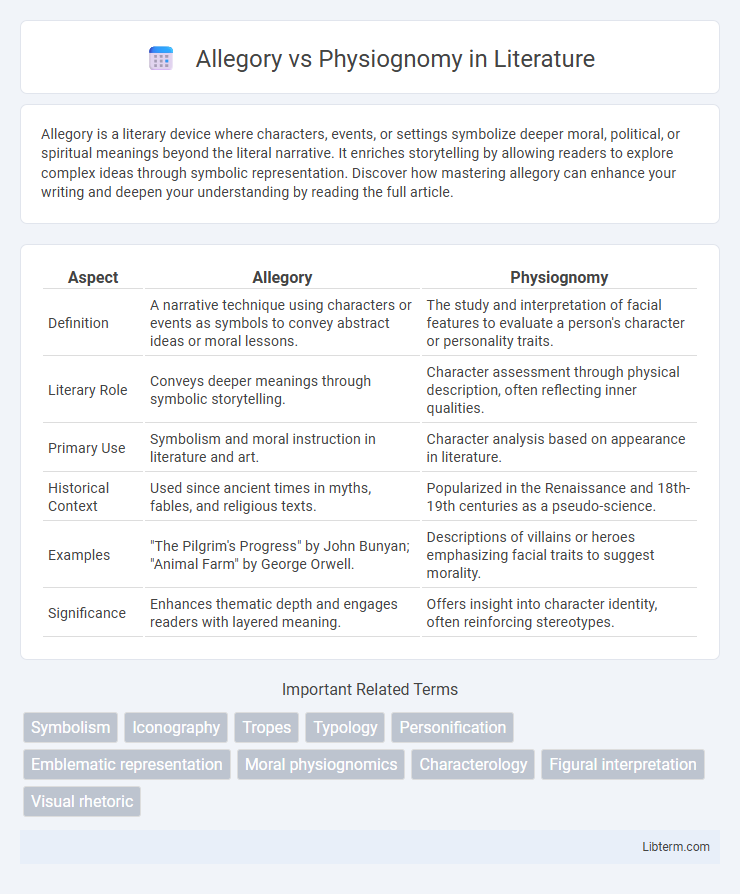Allegory is a literary device where characters, events, or settings symbolize deeper moral, political, or spiritual meanings beyond the literal narrative. It enriches storytelling by allowing readers to explore complex ideas through symbolic representation. Discover how mastering allegory can enhance your writing and deepen your understanding by reading the full article.
Table of Comparison
| Aspect | Allegory | Physiognomy |
|---|---|---|
| Definition | A narrative technique using characters or events as symbols to convey abstract ideas or moral lessons. | The study and interpretation of facial features to evaluate a person's character or personality traits. |
| Literary Role | Conveys deeper meanings through symbolic storytelling. | Character assessment through physical description, often reflecting inner qualities. |
| Primary Use | Symbolism and moral instruction in literature and art. | Character analysis based on appearance in literature. |
| Historical Context | Used since ancient times in myths, fables, and religious texts. | Popularized in the Renaissance and 18th-19th centuries as a pseudo-science. |
| Examples | "The Pilgrim's Progress" by John Bunyan; "Animal Farm" by George Orwell. | Descriptions of villains or heroes emphasizing facial traits to suggest morality. |
| Significance | Enhances thematic depth and engages readers with layered meaning. | Offers insight into character identity, often reinforcing stereotypes. |
Introduction to Allegory and Physiognomy
Allegory uses symbolic figures and narratives to convey complex ideas, morals, or political messages through metaphorical representation, often found in literature and art. Physiognomy refers to the practice of judging a person's character or personality traits based on their facial features, a concept with roots in ancient philosophy and pseudoscience. Understanding the distinct purposes of allegory and physiognomy reveals their roles in cultural expression and interpretation, highlighting allegory's abstract symbolism versus physiognomy's focus on physical appearance.
Defining Allegory: Meaning and Examples
Allegory is a literary and artistic device in which characters, events, or settings symbolize abstract ideas or moral qualities to convey deeper meanings beyond the literal narrative. Classic examples include George Orwell's "Animal Farm," where farm animals represent political figures and ideologies, and Plato's "Allegory of the Cave," illustrating human perception and enlightenment. Unlike physiognomy, which interprets physical appearance to infer character traits, allegory relies on symbolic representation to communicate complex concepts and ethical lessons.
Understanding Physiognomy: Historical Context
Physiognomy, rooted in ancient civilizations such as Greece and China, involves interpreting an individual's character through facial features, reflecting historical beliefs linking appearance to personality traits. This practice gained prominence during the Renaissance, intertwining with art and science as scholars attempted to decode human nature via physiognomic analysis. Understanding physiognomy's historical context reveals its influence on literature, psychology, and social perceptions, contrasting with allegory's symbolic representation of abstract concepts through broader narrative devices.
Key Differences Between Allegory and Physiognomy
Allegory represents abstract ideas or moral qualities through symbolic figures, actions, or imagery, often found in literature and art, whereas physiognomy involves interpreting a person's character or personality based on their facial features. Allegory communicates layered meanings and universal truths beyond the literal, while physiognomy relies on the belief that physical appearance reveals inner traits. The fundamental difference lies in allegory's use of symbolic narrative to convey complex concepts versus physiognomy's pseudoscientific attempt to deduce individual character from physical attributes.
Allegory in Literature and Art
Allegory in literature and art functions as a symbolic narrative where characters, events, and settings represent abstract ideas or moral qualities, enabling deeper thematic exploration. This technique allows creators to convey complex concepts like justice, virtue, or human folly through metaphorical storytelling that engages both intellect and imagination. Classic examples include John Bunyan's *Pilgrim's Progress* and Hieronymus Bosch's paintings, which use allegorical forms to critique society and human nature.
Physiognomy in Culture and Science
Physiognomy, the practice of assessing a person's character or personality based on their facial features, has historical roots in both cultural traditions and scientific inquiry. In culture, physiognomy influenced art, literature, and social judgments by linking appearance to moral or psychological traits, while in science, early physiognomic theories contributed to the development of fields like psychology and anthropology despite their controversial and often pseudoscientific status. Modern science has largely discredited physiognomy as a valid methodology, but its cultural impact persists in stereotypes and visual representations across societies.
Philosophical Perspectives on Both Concepts
Allegory represents abstract ideas or moral qualities through symbolic figures and narratives, fostering philosophical reflection on truth, ethics, and human experience. Physiognomy interprets character and personality based on facial features, engaging with historical debates about nature, identity, and the essence of human understanding. Both concepts explore representation and meaning, yet allegory emphasizes metaphorical truth while physiognomy attempts a direct linkage between physical appearance and inner reality.
Allegory vs Physiognomy: Interpretative Approaches
Allegory and physiognomy represent distinct interpretative approaches within literary and artistic analysis, where allegory relies on symbolic representation to convey deeper moral or political meanings. Physiognomy interprets characters' physical features as indicators of inner traits, reflecting historical beliefs about the connection between appearance and personality. These differing methodologies influence how audiences decode underlying messages, with allegory emphasizing abstract concepts and physiognomy focusing on embodied characteristics.
Contemporary Relevance and Criticisms
Allegory remains crucial in contemporary literature and art, serving as a powerful tool for encoding complex social and political critiques. Physiognomy, long discredited scientifically, faces ongoing criticism for perpetuating stereotypes and biases under the guise of character judgment based on physical appearance. Modern discourse challenges physiognomy's pseudoscientific basis while embracing allegory's versatility in addressing nuanced themes across cultures.
Conclusion: Interplay of Symbolism and Appearance
Allegory and physiognomy both rely on symbolic representations to convey deeper meanings, yet allegory employs abstract, narrative-driven symbolism while physiognomy interprets physical appearance as indicative of character traits. The interplay between symbolism and appearance allows for nuanced storytelling where external features reflect internal virtues or vices, enhancing thematic depth. Understanding this relationship enriches interpretations across literature, art, and cultural studies by blending visual and conceptual symbolism.
Allegory Infographic

 libterm.com
libterm.com